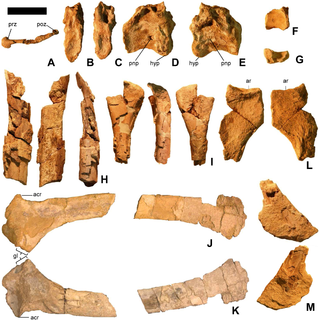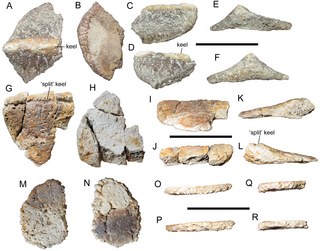
Utahraptor is a genus of large dromaeosaurid dinosaur that lived during the Early Cretaceous period from around 135 to 130 million years ago in what is now the United States. The genus was described in 1993 by an American paleontologist James Kirkland and colleagues with the type species Utahraptor ostrommaysi, based on fossils that had been unearthed earlier from the Cedar Mountain Formation of Utah. Later, many additional specimens were described including those from the skull and postcranium in addition to those of younger individuals.

Falcarius is a genus of primitive therizinosaur dinosaur that lived during the Early Cretaceous period in what is now North America. Its remains were first collected in the Cedar Mountain Formation in 1999, with subsequent findings made during the 2000s. The genus is known from multiple specimens ranging from immature to fully-grown individuals.

Adasaurus is a genus of dromaeosaurid dinosaur that lived in Asia during the Late Cretaceous period about 70 million years ago. The genus is known from two partial specimens found in the Nemegt Formation of Mongolia that were partially described in 1983 by the paleontologist Rinchen Barsbold.

Achillobator is a genus of large dromaeosaurid theropod dinosaur that lived during the Late Cretaceous period about 96 million to 89 million years ago in what is now the Bayan Shireh Formation of Mongolia. The genus is currently monotypic, only including the type species A. giganticus. The first remains were found in 1989 during a Mongolian-Russian field expedition and later described in 1999. Remains at the type locality of Achillobator may represent additional specimens. It represents the first and largest dromaeosaurid known from the Bayan Shireh Formation.

Thecocoelurus is a dubious genus of theropod dinosaur from the early Cretaceous period of England. The phylogenetic placement of this genus is uncertain, and it has been referred to an oviraptosaur, an ornithomimosaur, or a therizinosaur by different researchers throughout its history.
Venenosaurus is a genus of sauropod dinosaur that lived in what is now Utah during the Early Cretaceous. Its type and only species is Venenosaurus dicrocei. Fossils of Venenosaurus were first discovered in 1998, by Denver Museum of Natural History volunteer Anthony DiCroce, and described as a new genus and species in 2001 by Virginia Tidwell and colleagues, who named the species for DiCroce. Venenosaurus was a relatively small sauropod, and was similar to Cedarosaurus, another sauropod from the Early Cretaceous of Utah.

Cedrorestes is a genus of iguanodontian dinosaur from the Early Cretaceous of Utah. It is based on an incomplete skeleton which was found in the Valanginian-age Yellow Cat Member of the Cedar Mountain Formation.

Moabosaurus is a genus of turiasaurian sauropod dinosaur from the Early Cretaceous Cedar Mountain Formation of Utah, United States.

Dromaeosaurinae is a subfamily of the theropod group Dromaeosauridae. The earliest dromaeosaurine is Utahraptor, dating back to the Early Cretaceous period in North America, however, some isolated teeth seems to represent an indeterminate species of dromaeosaurine, coming from the Late Jurassic period in Africa. If true, this will push their range to the Jurassic period, instead of the Cretaceous, as in most dromaeosaurs.

Velociraptorinae is a subfamily of the theropod group Dromaeosauridae. The earliest velociraptorines are probably Nuthetes from the United Kingdom, and possibly Deinonychus from North America. However, several indeterminate velociraptorines have also been discovered, dating to the Kimmeridgian stage, in the Late Jurassic Period. These fossils were discovered in the Langenberg quarry, Oker near Goslar, Germany.

Luanchuanraptor is a genus of dromaeosaurid theropod dinosaurs from the Late Cretaceous of China. The genus is based on a partial skeleton from the Qiupa Formation in Luanchuan, Henan. They were medium-sized dromaeosaurids, the first Asian dromaeosaurid taxa described from outside the Gobi Desert or northeastern China.

Peloroplites is a monospecific genus of nodosaurid dinosaur from Utah that lived during the Late Cretaceous in what is now the Mussentuchit Member of the Cedar Mountain Formation. The type and only species, Peloroplites cedrimontanus, is known from a partial skull and postcranial skeleton. It was named in 2008 by Kenneth Carpenter and colleagues. Peloroplites was 6 metres long and weighed 2 tonnes, making it one of the largest known nodosaurids, and came from a time when ankylosaurids and nodosaurids were attaining large sizes.

Eudromaeosauria is a subgroup of terrestrial dromaeosaurid theropod dinosaurs. They were small to large-sized, feathered hypercarnivores that flourished in the Cretaceous Period.

Hippodraco is a genus of iguanodontian ornithopod dinosaur from the Early Cretaceous Cedar Mountain Formation of Utah, United States. The genus contains a single species, H. scutodens, known from a partial skeleton belonging to an immature individual.

Iguanacolossus is a genus of iguanodontian ornithopod dinosaur that lived in North America during the Early Cretaceous period. It is known from UMNH VP 20205, the associated holotype with a large partial skeleton of a single individual.

Geminiraptor is a genus of troodontid theropod dinosaur that lived in North America during the Early Cretaceous period. Geminiraptor was a small, ground-dwelling bipedal carnivorous paravian. The type species of Geminiraptor is G. suarezarum.

Ichthyovenator is a genus of spinosaurid dinosaur that lived in what is now Laos, sometime between 125 and 113 million years ago, during the Aptian stage of the Early Cretaceous period. It is known from fossils collected from the Grès supérieurs Formation of the Savannakhet Basin, the first of which were found in 2010, consisting of a partial skeleton without the skull or limbs. This specimen became the holotype of the new genus and species Ichthyovenator laosensis, and was described by palaeontologist Ronan Allain and colleagues in 2012. The generic name, meaning "fish hunter", refers to its assumed piscivorous lifestyle, while the specific name alludes to the country of Laos. In 2014, it was announced that more remains from the dig site had been recovered; these fossils included teeth, more vertebrae (backbones) and a pubic bone from the same individual.

Martharaptor is a genus of therizinosauroid theropod dinosaurs from the Early Cretaceous of the Cedar Mountain Formation in Utah. They can be distinguished from other therizinosauroids by means of several features of the skeleton which were intermediate between early therizinosaurs such as Falcarius and Beipiaosaurus, and more "advanced" members of the group like therizinosaurids. The deep and homogeneous hand claws clearly differ from the case in early therizinosauroids, but the foot has not yet acquired the robust morphology of therizinosaurids.

Mierasaurus is an extinct genus of sauropod dinosaur from the Early Cretaceous of Utah, United States. The taxon was first described and named in 2017 by Rafael Royo-Torres and colleagues, from a mostly complete skeleton including a disarticulated partial skull and mandible, teeth, multiple vertebrae from along the length of the body, both scapulae, radius and ulna bones, a left manus, a complete pelvis, both femora and the entire left hindlimb. Additionally, they referred a lower jaw and femur from juvenile individuals, which were found nearby, to the genus. Collectively, Mierasaurus is among the most completely known North American sauropods. The genus name honours Bernardo de Miera y Pacheco, the first European scientist to enter what is now Utah. The type species for Mierasaurus is Mierasaurus bobyoungi, named after Robert Glen Young, a paleontologist who researched the Early Cretaceous of Utah.

Invictarx is a monospecific genus of nodosaurid dinosaur from New Mexico that lived during the Late Cretaceous in what is now the upper Allison Member of the Menefee Formation. The type and only species, Invictarx zephyri, is known from three isolated, incomplete postcranial skeletons. It was named in 2018 by Andrew T. McDonald and Douglas G. Wolfe. Invictarx shares similarities with Glyptodontopelta from the Naashoibito member of the Ojo Alamo Formation, New Mexico.
























